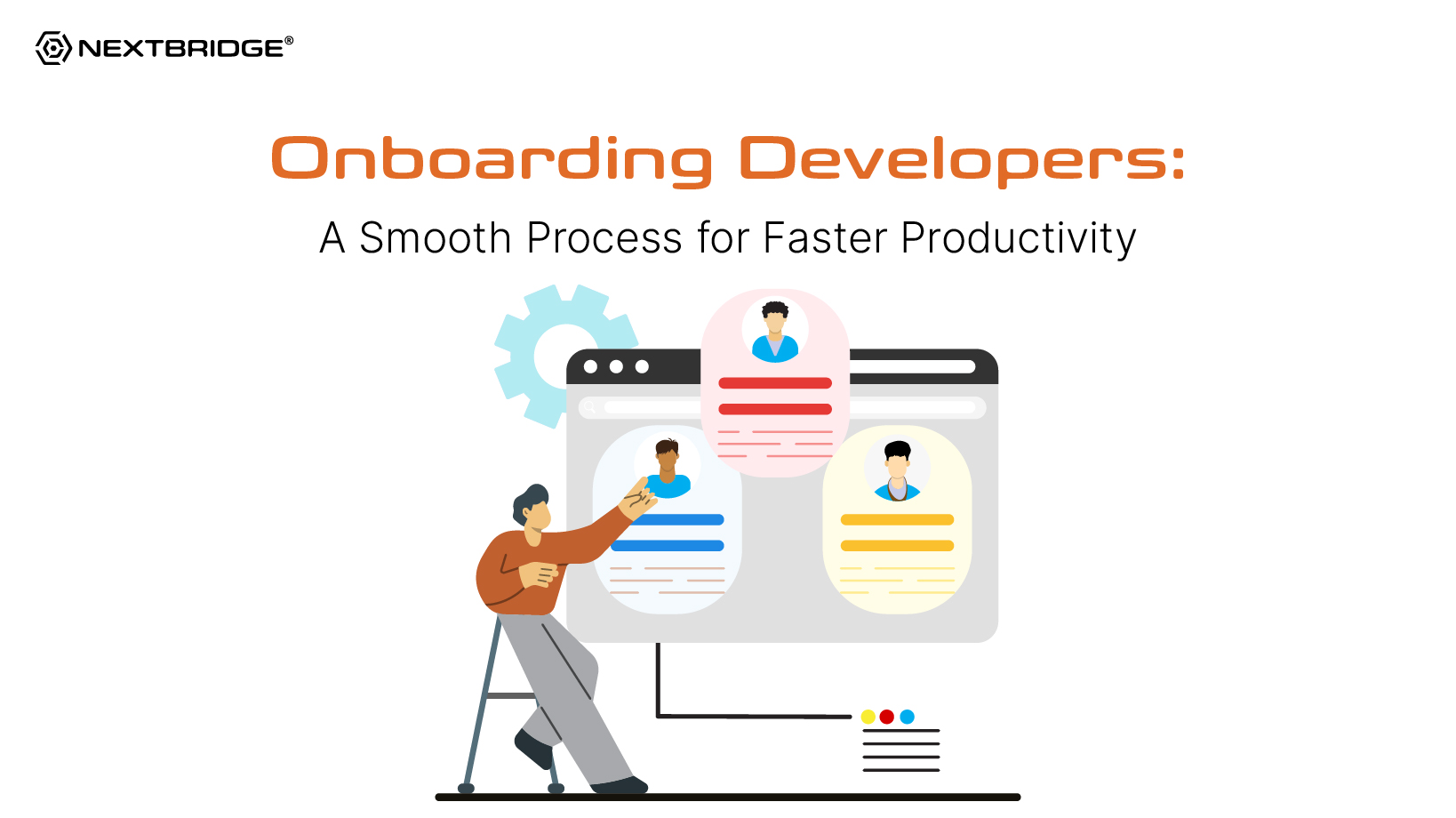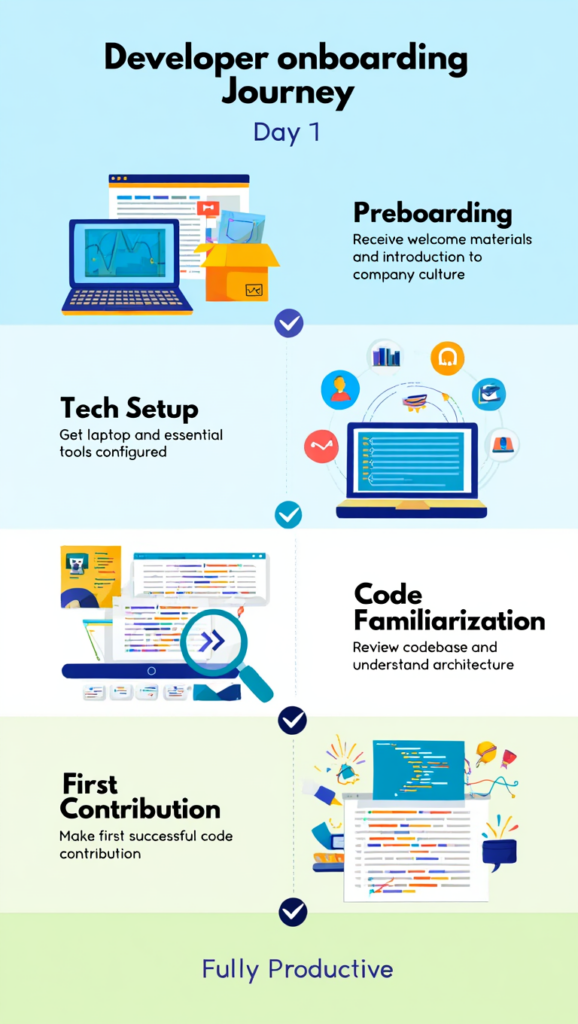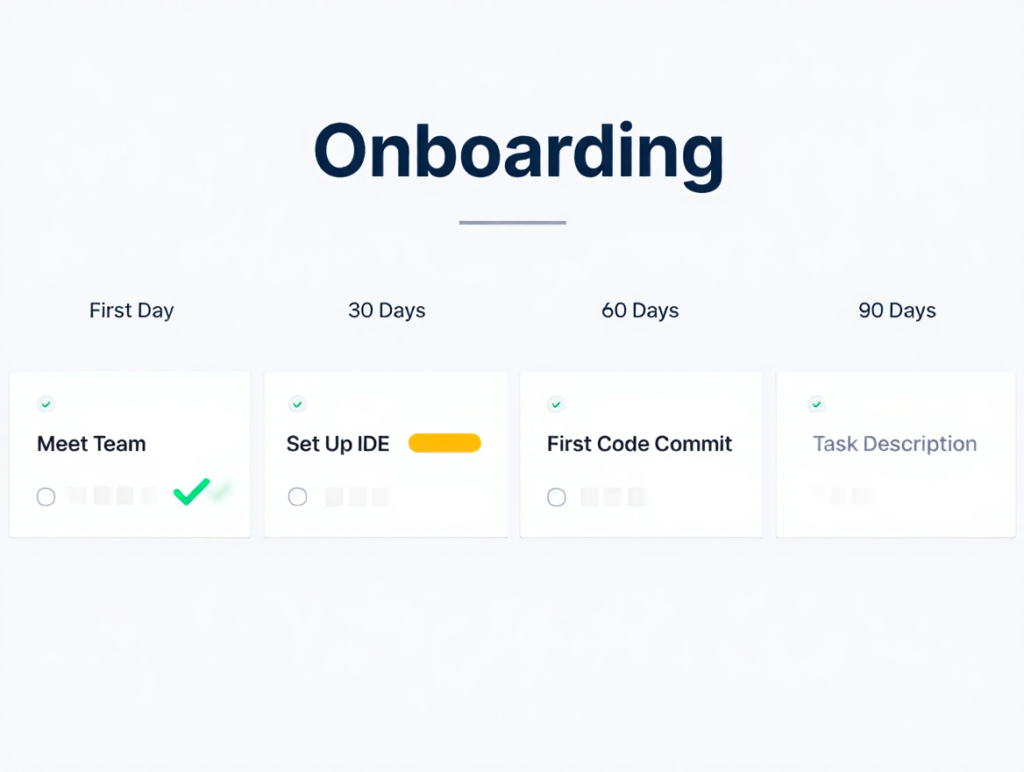 Back to all articles
Back to all articles
Blogs
Onboarding Developers: A Smooth Process for Faster Productivity


Onboarding developers can be a lengthy process, but the smooth execution is very important. Because it reduces the time that a new hire takes to understand and become a productive member of the current team.
When you hire a new software developer in your company, they have some expectations from you, like an automated and structured onboarding process. An entirely well-structured and smooth developer onboarding process can help you
- Make an inclusive and collaborative team culture
- Accelerate time-to-productivity for new hires
- Preserve the quality of code and consistency
In this blog, let’s take a look at the procedure for the smooth onboarding of developers
What is developer onboarding?
In simple words, onboarding developers is a procedure for incorporating new developers into the company’s team. Give them knowledge, resources, and tools to become a productive and efficient member of the team. A right onboarding process makes the new developer feel more welcomed, supported, and prepared to contribute effectively.
These are the essential elements of onboarding:
Company
- Assure that the new employee aligns and understands the company’s values, mission, vision, and culture.
- Give the new developer details about workflows, processes, communications styles, and team dynamics.
- For smooth integration in the software development environment with a shorter learning curve, also tell them good practices.
- Clearly explain these things: key departments, leadership roles, and overall organizational structure.
Team
- The team should clearly define the goals, responsibilities, new role, and KPIs to the new employee.
- Give a short introduction and let the new member interact with the team, work buddies, and other employees.
- Keep the engagement high via interactive sessions, regular check-ins, and feedback.
Technology
- New hires learns via the development environment and the tech stack, which includes setting up and configuring new apps and tools.
- Support developers in understanding the existing codebase, coding standards, and architecture. It will also require walkthroughs, code reviews, and documentation.
- Help the new joiner be familiar with the company’s services, products, and code base, which includes coding standards and architecture.
Developer Onboarding Process
The onboarding process for developers is very simplified if it is done strategically. Here are the details for better understanding.
Step 1: Preboarding
Purpose: It helps in building excitement in new employees and decreases the elements of nervousness on the first day.
Key Actions
- Firstly, provide all the necessary credentials.
- Communicate all the onboarding goals, work policies, the company's hierarchy, and technologies.
- Assign a system with already installed software.
- Introduced with a work buddy or mentor.
Step 2: Day One Essentials
Purpose: It's important to build a strong impression and keep the first day as easy as possible.
Key Actions
- Always give a warm welcome to new employees
- Give a brief overview of technical documentation and technology used in projects.
- Ensure the environment is set up for the developer.
- Also, share the company’s mission, vision, and coding standards with new developers.
Step 3: Role Specific Training
Purpose: The main aim of this is to provide developers with the knowledge which is required according to their job descriptions.
Key Actions
- For Front-end: UI frameworks and design systems.
- For Backend: Database architecture and APIs.
- For full-stack: Combines front-end, back-end, and DevOps.
- For Mobile: Platform guidelines, frameworks, and testing.
Step 4: Codebase Familiarization
Purpose: This step decreases the ramp-up time, allows new users to build confidence with code.
Key Actions
- Detailed guidance about walkthroughs.
- Always get familiar with the documentation.
- Get started with basic tasks like fixing small issues and reviewing the code.
Step 5: Collaboration Tools Training
Purpose: The purpose of this step is to maintain hassle-free teamwork and communication.
Key Actions
- Use the latest project management tools.
- Do version control with GitHub with branching methods.
- For better communication, use tools like Slack, Teams, and email.
- For CI/CD & DevOps, use tools like Jenkins, Docker, and GitHub actions.
Step 6: Pair Programming & Mentorship
Purpose: The basic aim of this step is to give contact support and guidance.
Key Actions
- Pair programming sessions
- For day-to-day guidance, assign a workbuddy or mentor.
- Keep regular manager check-ins or standups.
- Keep the feedback loop constantly open for checking the progress.
Developer Onboarding Checklist
Here is the checklist for onboarding developers

First Day
- Share the detailed agenda.
- Schedule the meetings with HR and other team members.
- Share a single onboarding document with all the links.
- Assign a work buddy or mentor.
- Set up all the accounts and give the necessary access.
First 30 days
- Assign small tasks for quick wins.
- Plan daily check-ins with managers.
- Conduct knowledge-sharing sessions.
- Get involved in team meetings and activities for collaboration.
- Keep the loop of feedback established.
First 60 days
- Provide them with the opportunity to collaborate with senior developers.
- Offer more training sessions according to their skills.
- Keep the performance goals set and do mid-point interviews.
First 90 days
- Check progress according to fixed benchmarks and goals.
- Also, get feedback from other team members too.
- Praise short achievements and milestones.
Best Practice for Developer Onboarding

Here are the best practices for onboarding developers:
- Customized onboarding according to the team culture, role, and experience with flexibility.
- To decrease the ambiguity and build trust, set fixed goals for 30, 60, and 90 days.
- For a smooth learning experience, give proper guides, documentation, and tutorials.
- Give a proper introduction about the company’s values, mission, and culture from the beginning.
- IDPs, coding playgrounds, and virtual setups are the best modern tools for smooth onboarding.
- Constantly keep track of feedback and metrics, and also refine the process.
Conclusion
Developer onboarding is an easy process if it's done with the ight strategies. It can enhance the productivity of the developer through strong collaboration. The key factor is to keep the onboarding process flexible, constantly evolving, and provide feedback-driven. Use appropriate tools to make this process easier and much smoother for the new employee.
Don't hire us right away
talk to our experts first,
Share your challenges, & then decide if we're the right fit for you! Talk to Us
Partnerships & Recognition
Commitment to excellence






